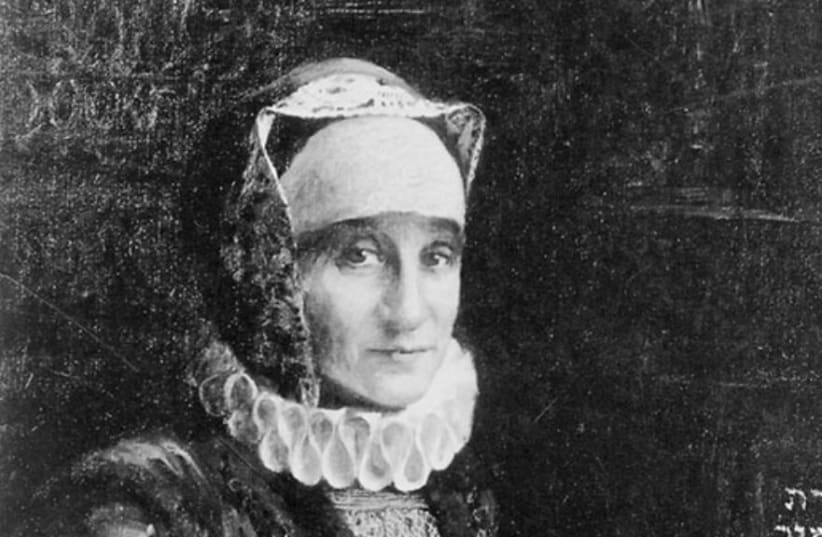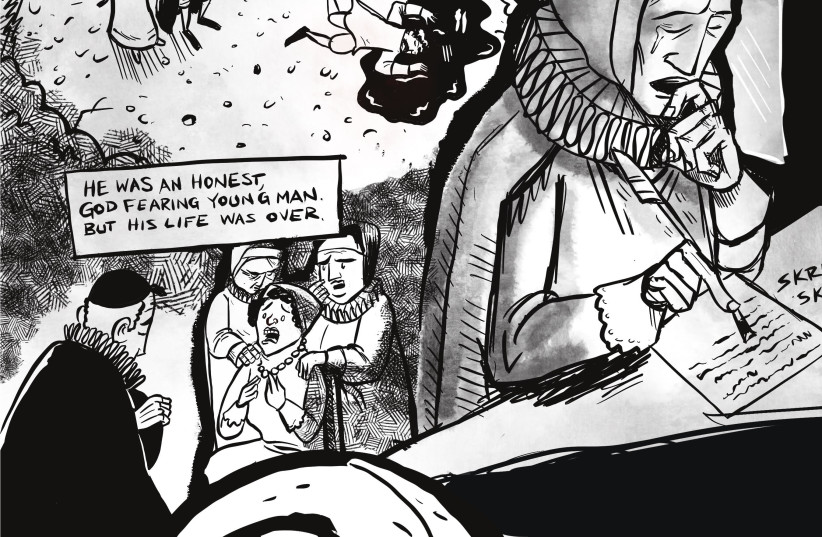Glikl of Hamlyn may have lived more than 400 years ago, but in many ways her life’s ambitions and struggles mirror today’s issues. The Jewish woman, whose 20-year diary describes life in Europe’s 17th century, has been turned into a graphic novel by a husband-and-wife team of educators. Mat and Julie Tonti spoke to the Magazine about their forthcoming project aimed at making a digestible version for today.
Mat and Julie live with their children in the Washington, DC area, where they both work in the field of education, Mat as a rabbi and educator at Milton Gottesman Jewish Day School, and Julie as director of educator services at The Associated: Jewish Federation of Baltimore. The couple were recently in Israel, which followed their visit to Germany where they tracked down where Glikl lived, worked and prayed.
Born in approximately 1646, she lived mostly in Hamburg, in today’s Germany. She is usually referred to as Glikl of Hamlyn, her husband’s hometown, which is also spelled Hamelin, famous for the story of the Pied Piper.
The name Glikl means “luck,” explained Julie, and was a common name for Jewish women at the time. Her name is sometimes spelled Gluckel or Glueckel but pronounced Glikl in Yiddish, the language in which she wrote her memoirs. She is also referred to by her Hebrew name, Glikl bas Leib, which is now her Instagram feed thanks to the Tontis.
“She’s a really good example of a successful woman. She shows what it means to work hard and have a good relationship with your husband.”
Julie Tonti
“She’s a really good example of a successful woman,” Julie explained. “She shows what it means to work hard and have a good relationship with your husband.” Glikl lived well into her 80s and had 14 children, 12 of whom lived into adulthood.
Glikl of Hamlyn: An example of a successful Jewish woman
Glikl and her husband Haim of Hamlyn worked together and created a successful family business in the cosmopolitan port city of Hamburg. When her beloved husband passed away, Glikl turned to writing as a way to cope and as something to pass down to future generations.
The family was very devout and would be described today as Orthodox. “She lived by the Torah and died by the Torah,” Mat explained. Any suffering she experienced, she ascribed to her own sins, while any stroke of good fortune was attributed to God and was a cause for celebration. Her writings are important for creating a broader understanding of life in Europe in general and for the Jewish community in particular.
Why did Jews live in Germany for so long if things were so bad?
A question that students often ask the Tontis is why Jews lived in Germany for so long if things were so bad. “Talking about Germany in the post-Holocaust era is a challenge,” Julie stated. “But we could see that Hamburg is a beautiful city and was a great place to run a business.”
The Tontis personally experienced the dichotomy when they were yelled at in German on multiple occasions for minor infractions. For Jewish American tourists, the focus on following rules and the tone in which it was stated brought up some complex emotions. But the beautiful river and scenery were breathtaking.
They were assisted in their trip by German tour guide Andreas Kowalski, who although not Jewish, has made it his life’s mission to explain Judaism and Jewish history. “He helped us so much, and we now have an everlasting friendship,” Julie said. The tour guide helped the couple navigate where Glikl lived and what her life looked like visually. They noted that the tour of the city would have taken twice as long in the Middle Ages, when the convenience of modern transportation was unfathomable.
Glikl enjoyed the cultured atmosphere of Hamburg, and in her diaries she writes that she much preferred it to her husband’s hometown of Hamlyn, which was a little too provincial for her.
In addition to her description of a thriving Jewish community, there were also instances of Judeophobia.
In the mid-1600s, the Ashkenazi Jewish community was expelled from Hamburg and forced to resettle in nearby Altona. The Sephardic Jews from Spain and Portugal were allowed to stay because they were seen as more economically useful. When Glikl was a girl, her family was among those who moved to Altona and then several years later, back to Hamburg.
Antisemitism and a pandemic in 17th-century Germany
In addition to antisemitism, there was a pandemic. “When she was a young child, her family took in Jews who had to flee from Poland because of massacres,” Julie stated. “About 10 of them came to stay in her house and some were quite sick.”
Glikl wrote that every member of the household contracted the disease ravaging Europe, and although most recovered, her grandmother succumbed to the illness.
She also described an incident that occurred on Sukkot, in which their three-year-old daughter was found to have a sore under her arm. Fearing it was the plague, they quickly ushered her out of the synagogue and sent her off to a nearby village for the duration of the festival. Not only did they fear spreading the deadly virus but also the authorities who would have quarantined the entire community and blamed the Jews for spreading the disease.
HER LIFE events, both happy and sad, filled the thoughts of Mat and Julie as they visited her hometown. They saw the old cemetery and took photos of the graves of Haim of Hamlyn and many of Glikl’s relatives, although Glikl herself was buried in France.
Much of historic Hamburg was destroyed in a fire in 1842, and during World War II the Allies bombed Hamburg in their fight against the Nazis. But the Tontis felt a need to make their book as authentic as possible and saw many houses that gave them an idea of what Glikl’s home may have looked like.
“From an artistic point of view, I really wanted to up the game for this book,” Mat said. “There are some great artists who make the reader really feel like they are in that place in time. And so part of the reason for us going to Germany was to breathe the air, walk the roads and really try to get a feel for the life she lived.”
Commented Julie: “Her diary is very relatable in that even though 400 years have passed, we have similar concerns and issues. The problems of her day have not fully been solved, even though we have innovations in public health and modernity.”
“Her diary is very relatable in that even though 400 years have passed, we have similar concerns and issues. The problems of her day have not fully been solved, even though we have innovations in public health and modernity.”
Julie Tonti
While in Israel, the couple also met with Chava Turniansky, professor emerita in the Department of Yiddish at the Hebrew University of Jerusalem, who is the editor of a modern, authoritative translation of Glikl’s diary, which was released in 2019. The Tontis hope to use her version of the diary in their graphic novel.
Julie said she feels that Glikl’s diaries are an invaluable teaching tool for young Jews but are not always easy to read. The translation from Yiddish and the wordiness of her text can make it hard for a youth raised in the Internet age. “Kids today need sound bytes. They are more visual,” Julie explained.
Graphic novels: A useful took to teach children
That is where the idea of a graphic novel comes in. The comic-book format is something Mat excels at. His 2020 debut novel, The Book of Secrets, is a colorful, imaginative romp starring a boy and girl who travel through a world filled with classic Jewish folk tales and hassidic stories.
They hope the new book will be both serious and relatable for kids and adults. “My main goal is to translate Glikl’s voice, but through Julie’s understanding of it,” he said.
Through the plague, antisemitism, faith, motherhood, business success and financial woes, Glikl’s life will hopefully shed light on a vanished world that may not be so different from our own.
Until the book comes out, the Tontis have created a Glikl Instagram profile at @glikl.bas.leib, where fans can follow the travels of this woman from the past. For more information: www.MatTonti.com.

